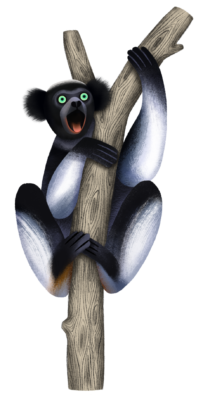Scientific Name: Indri indri
Download as PDFWeighing 6-9.5kg, the Indri is the largest living lemur species. Indris are diurnal, which means they are active during the day. They are easily identified by their loud, haunting calls used to maintain territory.
Diet
Indris are folivores, eating mostly immature leaves. They also eat flowers, fruit, seeds, and bark, and occasionally descend from the trees to eat soil. Scientists think they may use soil to reduce toxins in seeds they eat.
Family
Indris live in groups of 2-6 individuals (monogamous pairs and their children). Like most lemur species, Indris are female dominant. However, unlike other species, Indris do not reach reproductive maturity until 7-9 years of age, and females only give birth every 2-3 years! This slow reproductive rate makes it difficult for Indri populations to grow.
Geographic Range
Indris are found in tropical moist lowland and montane forests of eastern Madagascar. Their geographic range extends from the Anosibe an’ala Classified Forest in the south to the Anjanaharibe-Sud Special Reserve in the north (not including the Masoala Peninsula).
Conservation Status
Indris are classified as Critically Endangered on the IUCN Red List. Their numbers are decreasing, and the overall population is severely fragmented. Individuals cannot easily reach each other to reproduce, usually because the forest itself is fragmented. These “holes” in the Indris’ habitat make it difficult for them to maintain and grow their numbers.
Threats
The main threats to Indris are habitat destruction from slash and burn agriculture, logging, and fuelwood gathering for charcoal production. Poaching is also a major issue. Fady (traditional beliefs/taboos) that once protected Indris from being hunted by locals are becoming less respected. This has led to an increase in hunting, especially since the political crisis in Madagascar that began in 2009.
LCN Members Working to Save Indris
- Madagasikara Voakajy
- Madagascar Fauna & Flora Group
- GERP
- Association Mitsinjo
- Lemur Conservation Foundation
Where to Indri In Madagascar
- Analamazaotra Special Reserve and Association Mitsinjo Reserve, both in Andasibe
- Anjozorobe-Ankavo, about 90 minutes from Antananarivo
- Anjanaharibe-Sud Special Reserve, about 15km southwest of Andapa
- Zahamena National Park and Strict Nature Reserve
- Marotandrano Special Reserve





